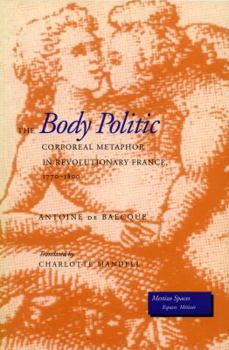The Body Politic: Corporeal Metaphor in Revolutionary France, 1770-1800
Select Format
Select Condition 
Book Overview
This is a remarkable history of the French Revolution told through the study of images of the body as they appeared in the popular literature of the time, showing how these images were at the very center of the metaphoric language used to describe the revolution in progress. The author draws upon some 2,000 texts, pamphlets, announcements, opinions, accounts, treatises, and journals to exhume the textual reality of the Revolution, the body of its history. The deployment of bodily images--the degeneracy of the nobility, the impotence of the king, the herculean strength of the citizenry, the goddess of politics appearing naked like Truth, the bleeding wounds of the Republican martyrs--allowed political society to represent itself at a pivotal moment in its history. Searching for "the body of history," the author finds three forms of political representation: first, the metaphysical representation of the body as an anthropomorphic symbol of the political system--the transition of sovereignty from the body of the king to the great citizen body; second, the metaphorical representation of the body as a tool of discourse for persuasion--the embodied tale of the revolutionary epic; and third, the representation of the body in public ceremonies--street carnivals and funerals. The introductory chapter studies the symbolic defeat of the king's body and the transfer of virility to the Republican body. Later chapters examine the new patriotic body as described in medical terms; paintings by David that show the revolutionary hero as "political body"; the Revolutionary subject conceived in terms of regeneration; its opposite, the aristocratic body, conceived as monstrous; and the bestial images projected onto Marie Antoinette.
Format:Paperback
Language:English
ISBN:0804728178
ISBN13:9780804728171
Release Date:October 1997
Publisher:Stanford University Press
Length:384 Pages
Weight:1.20 lbs.
Dimensions:0.8" x 6.0" x 9.0"
Customer Reviews
1 rating
Good in its own way
Published by Thriftbooks.com User , 23 years ago
An explanation of my reasons for reading this book will help. I'm taking a 400 level history course on the French Revolution and this book is on the list of optional texts. I chose to read it because I thought an exploration of corporeal metaphor would be quite interesting.The book, for the most part, was worth the read. It is divided into, I think, 3 parts and 9 sections. In some ways the nine sections are like independent essays related only by the similarity of the very general topic of bodily imagery. There is some structure within the parts, and throughout the work as a whole, though it is loose. Of the 9, the first and last were most interesting to me - the first is about the royal sex as a ceremony, the consumation of Louis' marriage with MA, etc. The last section is about the use of dead or wounded people as martyrs to the revolutionary cause. The other sections (which include one on Abbe Sieyes, one on David's paintings, etc.) are interesting, but somehow seem related less directly to issues which seem important to me; the first discusses perceptions of the king (physical impotence as it was associated with political impotence, etc.) and the last the abuse of rhetoric(maybe that's a bad label). The rest of the sections seem to address more peripheral issues.The writing (or perhaps I should say the translation) is clear and readable enough. It is almost, though, more philosophical than historical. De Baecque remains firmly (for the most part) on the level of abstractions - many of the distinctions he draws, categories he imposes, connections he makes, are very theoretical, even to a fault. But despite that, the book is, on the whole, well done. It will appeal only to students of the Revolution - it is a kind of specialty item. A fairly deep knowledge of the revolution is needed to approach it.





